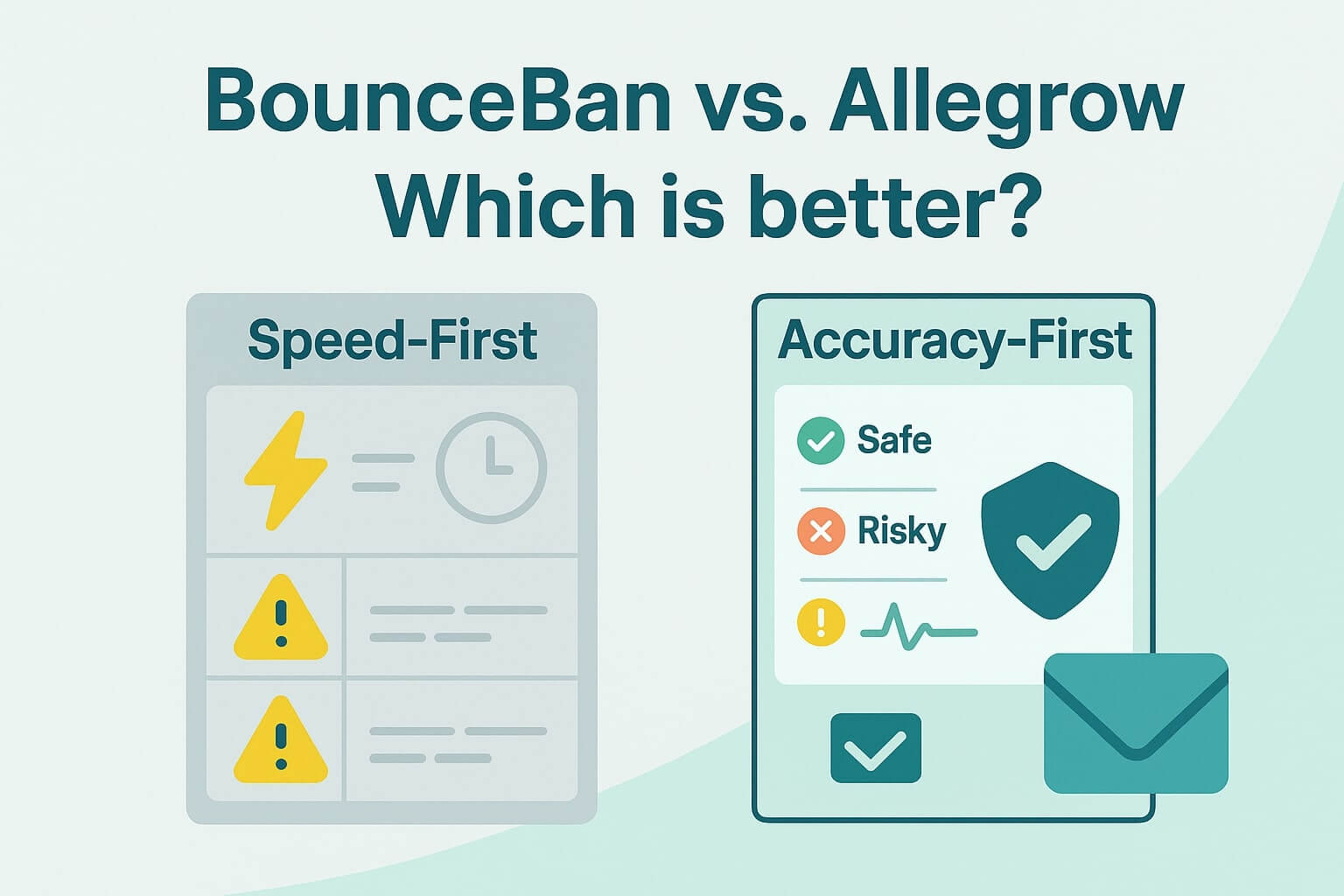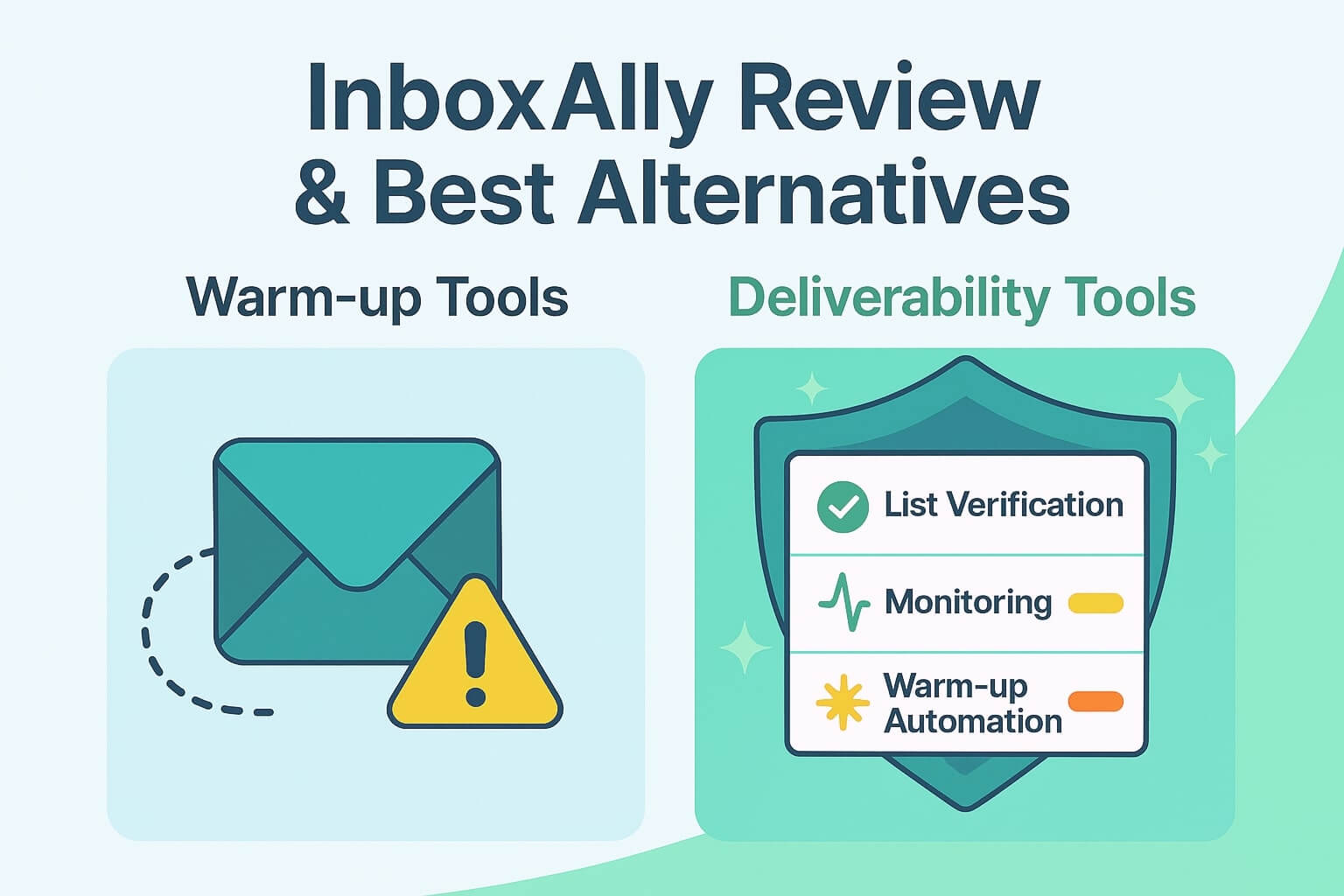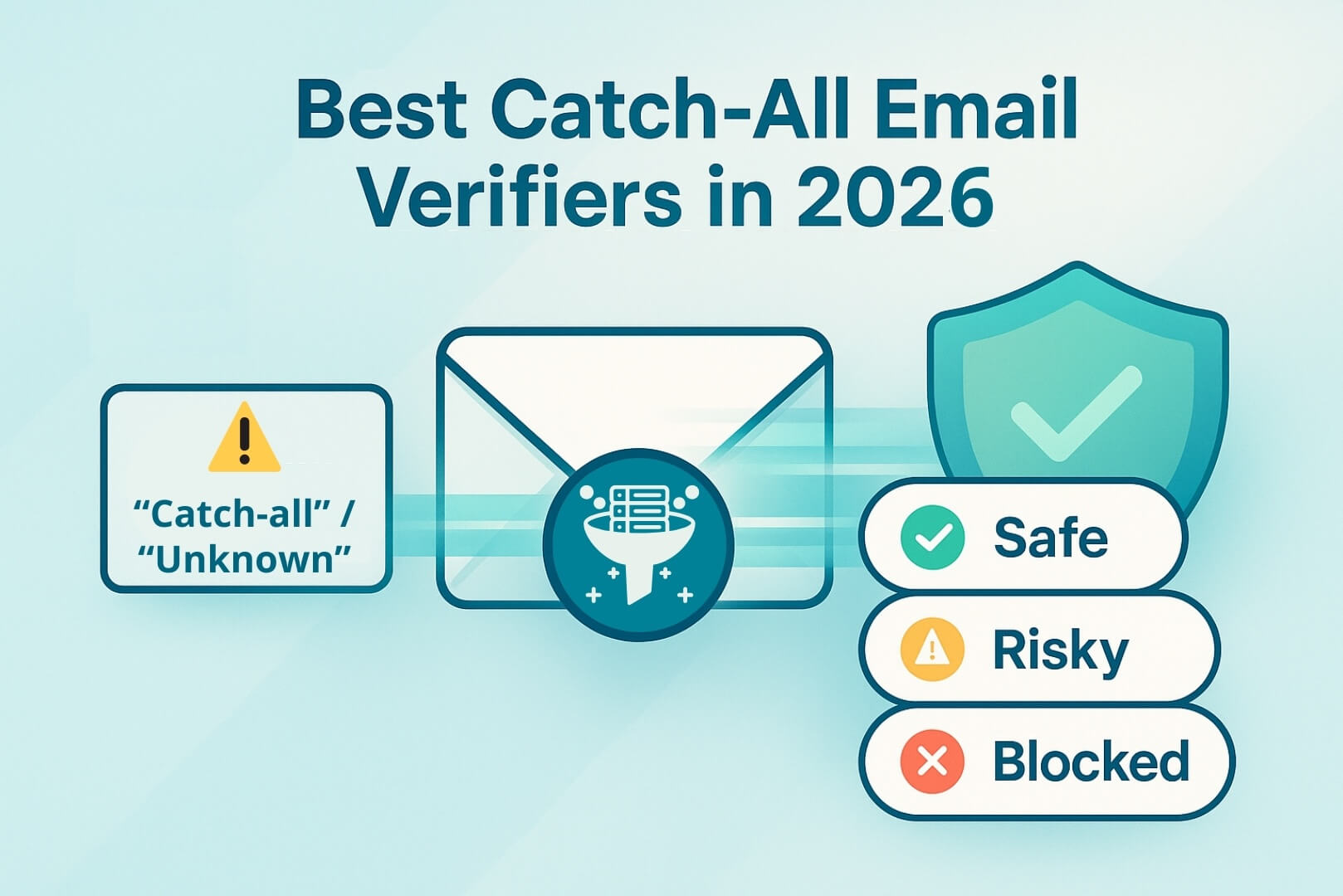In the high-volume world of B2B lead generation, BounceBan has earned its reputation as the "speed-first" option. It is famous for churning through massive, cold email lists quickly and offering decent coverage for difficult "catch-all" domains. If your primary goal is to scrub a 100,000-row CSV in minutes for a one-off blast, it is a strong tool.
But for modern revenue teams, "speed" isn't the only metric that matters anymore.
The rise of stricter spam policies from Google and Microsoft in 2025 has shifted the goalposts. It is no longer enough to know if an email exists (is it valid?); you need to know if it is safe (is it a spam trap? Is it an inactive inbox that will burn your domain?).
This guide compares BounceBan against Allegrow to help you decide which verification philosophy fits your data strategy:
- The Speed-First Approach (BounceBan): For bulk processing where raw throughput is king.
- The Infrastructure Approach (Allegrow): For teams that need deep-risk intelligence, proactive automated protection, and configurable control over their verification logic.
Let’s dive into the data.
TL;DR: When choosing a verification provider, the decision comes down to throughput versus safety. BounceBan is a "speed-first" bulk processor ideal for churning through massive, cold legacy lists (Proofpoint-heavy) where raw speed is the priority. Allegrow is an "accuracy-first" infrastructure alternative designed for modern B2B teams and Data Providers who require deep-risk intelligence. If you need to identify hidden spam traps, manual complainers, and inactive mailboxes behind catch-all domains, or if you need configurable API logic to meet strict SLAs, Allegrow’s triple-verification method offers the superior, safer choice.
The Core Philosophy: Speed-First vs. Accuracy-First
At their core, BounceBan and Allegrow were built to solve two different problems. One was built to process massive lists as fast as possible; the other was built to navigate the complex, high-risk infrastructure of modern B2B email.
BounceBan: The "Speed-First" Engine
BounceBan is engineered for bulk throughput. Its primary use case is taking a massive, cold email list (think: 100,000+ rows scraped from LinkedIn or Apollo) and churning through it to find "deliverable" emails quickly.
If your only KPI is "how fast can I get a result for this CSV", BounceBan is a strong contender.
However, speed isn't always guaranteed. User reviews and documentation highlight a critical "black box" limitation: when BounceBan hits a difficult catch-all domain, the verification process can lag significantly, taking anywhere from 1 to 6 minutes per contact.
Because the system is a "black box", you have no control over this latency. You are locked into their wait time, which makes it difficult to build real-time applications or user-facing workflows where a 6-minute delay is unacceptable.
Allegrow: The "Accuracy-First" Infrastructure
Allegrow is engineered for risk intelligence. We don't just ping a server to see if it responds; we use a Triple-Verification Method to analyze the safety of the mailbox.
Our system layers three distinct checks:
- Syntax Validation: Checking structure and format.
- SMTP Handshake: Verifying the server exists without triggering a block.
- Proprietary Signal Analysis: The most critical layer. We analyze behavioral signals to determine if a mailbox is actually active or if it is a dangerous "zombie" account.
This depth allows us to identify the risks that faster, lighter tools often miss. We don't just tell you if an email is valid; we identify Manual Spam Reporters, Inactive Mailboxes (dead addresses that don't bounce yet), and Spam Traps, even in the most challenging catch-all domains. In the current deliverability climate, avoiding these "silent killers" is far more valuable than raw speed.
Catch-All Verification: The "Quality" Difference
In B2B prospecting, "catch-all" (accept-all) domains are the single biggest source of anxiety, with approximately 30% of B2B email servers now configured as catch-alls. Because these servers accept all incoming mail at the door, standard verifiers hit a wall, unable to tell if a specific inbox inside actually exists. Crucially, this ambiguity makes catch-all domains the favorite hiding place for spam traps.
This creates a high-stakes puzzle: you need to verify these accept-all contacts to scale your outreach, but "guessing" wrong can ruin your deliverability. Different tools attempt to solve this puzzle in very different ways.
The BounceBan Approach: Statistical Probability
BounceBan is widely recognized for its ability to verify catch-alls, often claiming high "valid" rates where other tools return "unknown".
Their approach often relies on statistical probability and AI pattern matching. They analyze the domain's patterns to determine if an email is "likely" valid. While this gives you maximum coverage (more "valid" emails to send to), it comes with an inherent risk of false positives. A "likely valid" email is not the same as a confirmed one, and when you are sending at scale, those small margins of error can accumulate into a reputation problem.
The Allegrow Approach: Definitive Risk Analysis
At Allegrow, we don't believe in "likely". We believe in definitive.
We use proprietary logic, built on our extensive experience and database of active B2B mailboxes, to assign a definitive "Valid" or "Invalid" status to catch-all contacts. We don't guess based on patterns; we verify based on signals.
If we cannot 100% confirm that a catch-all address is safe, active, and valid, we will not mark it as "Valid".
This difference comes down to your risk tolerance. In the current climate, it is far better to send to fewer, definitely valid contacts than to burn your domain's reputation by blasting thousands of "likely" valid ones.
SEG Performance: Mimecast vs. Proofpoint
If you are selling to the Fortune 500 or the fast-moving Tech/SaaS world, your emails aren't just going to a Gmail inbox; they have to pass through a Secure Email Gateway (SEG) first. These are the bouncers at the door of the corporate server, and the two biggest players, Mimecast and Proofpoint, require very different approaches to navigate.
For modern revenue teams targeting Tech, SaaS, Finance, or Professional Services, you will likely face Mimecast.
Mimecast uses dynamic, behavioral filtering that often blocks standard verification "pings", causing many tools to return a useless "Unknown" status. This is where Allegrow outperforms. Because our validation engine is built on proprietary behavioral signals rather than simple server pings, we can penetrate Mimecast's logic more effectively. This allows us to determine if a protected inbox is truly active without triggering a false positive, helping you reclaim valid leads that other tools miss.
On the other side of the spectrum is Proofpoint, which dominates the Legacy Enterprise, Manufacturing, and Healthcare sectors.
For Proofpoint, BounceBan has historically performed well. Their statistical model is effective at navigating the older, more static rule sets often found in legacy Proofpoint configurations.
Ultimately, your choice should be dictated by your audience. If you are selling to the modern economy (Mimecast-heavy), Allegrow’s signal-based verification is a critical asset. If you are exclusively targeting legacy industries (Proofpoint-heavy), BounceBan remains a capable choice for that specific slice of the market.
For B2B GTM Teams: Domain Protection & Predictable Costs
For a modern RevOps leader, verification isn't just about "cleaning a CSV"; it's about protecting the pipeline and your team's time, as studies show that sales reps waste 27.3% of their total selling time chasing bad leads. The biggest difference between these two tools isn't just in how they verify email, but also in how they fit into your daily sales workflow.
Moving from "CSV Cleaning" to "Pipeline Protection"
BounceBan operates primarily as a standalone utility. To use it, teams typically export a CSV, upload it, wait, and import it back. While you can automate this via their API, it requires a dedicated engineering effort to build and maintain that custom middleware — a heavy lift for most sales ops teams. Without that custom engineering, there is no native guardrails to stop a sales rep from manually adding a risky contact and hitting "send" immediately.
Allegrow takes a different approach by integrating natively into your execution platforms, like Outreach, Salesloft, and HubSpot.
We built a "Safety Net" that sits inside your sales workflow. Instead of relying on manual cleaning or custom API code, Allegrow checks every single email automatically before the sequence step is executed. If a contact is identified as a spam trap or high-risk catch-all, our system blocks the send in real-time. This moves you from a reactive "clean-up" model to a proactive protection model, ensuring no human error can burn your domain.
Elimination of "Credit Anxiety" with Unlimited Verification
The pricing model of your verification tool has a surprising impact on your team's behavior.
BounceBan uses a traditional credit-based model: you pay for every email you verify. While flexible, this creates "credit anxiety". Reps and managers hesitate to re-verify older lists because it costs money every time. As a result, data decays, and you end up sending to valid emails that turned into bounces three months later.
Allegrow operates on an Unlimited Verification Subscription. We believe safety shouldn't have a meter running.
Because you aren't paying per check, you are encouraged to re-verify your entire database every single month. This aligns perfectly with the high-frequency nature of B2B sales. It allows you to catch "silent killers" — like mailboxes that have gone inactive, spam reaps or users who have are likely to spam report — without ever worrying about blowing your budget. You pay for uptime, not for credits.
Here's a video from our co-founder discussing how the platform works. You can view the Allegrow Platform Walkthrough to see the features discussed in this section, such as the Safety Net, in action.
For Data Providers: Industrial-Grade Infrastructure (API)
When moving millions of records, you aren't shopping for a verification tool — you are shopping for mission-critical infrastructure. The core need shifts from basic accuracy to control, stability, and integration flexibility.
The Control Gap: Configurable Logic vs. the Black Box
BounceBan's API, like many bulk verifiers, is a "black box". It gives you a final result but offers very little transparency or control over the methodology used. This rigidity is a major liability for Data Providers who need to maintain specific service tiers.
Allegrow is built to function as a customizable component within your own product:
- Configurable Logic: This is our most significant technical differentiator. We allow API users to customize their preferred mix of Syntax checks, SMTP checks, and Proprietary signals. A Data Provider can tune the verification methodology to perfectly match a client's risk profile — using a deeper SMTP mix for a financial services client, for example — something rigid APIs simply cannot do.
- Architectural Flexibility & Uptime: Data Providers are governed by strict SLAs (e.g., 99.9% uptime and <300ms latency for real-time services).
- The Latency Risk: BounceBan's unpredictable 1–6 minute lag on difficult catch-alls breaks any real-time application and creates integration failures.
- Allegrow's Solution: Our infrastructure is designed for high concurrency. You can choose the implementation that suits your needs: Synchronous (for low-latency, real-time UI verification) or Asynchronous (for high-volume, deep-risk batch processing), allowing you to meet client SLAs consistently.
Scale, Partnership, and Security
For mission-critical APIs, the cost of failure far outweighs the cost per check.
- Financial Stability & Scale: We offer custom volume pricing built for predictable budgeting at massive scale. Furthermore, we provide Unlimited API Keys per subscription, allowing your engineering team to manage multiple workflows, environments, and client accounts without being restricted by vendor key limits.
- Data Security and Compliance: For partners handling sensitive data, stability goes beyond uptime. We adhere to strict data privacy protocols (e.g., SOC2, GDPR/CCPA readiness). All verification requests are processed securely, and no contact data is ever stored on Allegrow servers after processing, minimizing legal exposure for our partners.
- The Partnership Model: Allegrow isn't just a vendor. We offer an "Approved Data Partner" program that lets you embed our proprietary verification features directly into your SaaS or data product. This relationship is backed by dedicated, engineer-to-engineer technical support via Slack and Zoom, giving you a collaborative partner who understands API stability — a necessity when your product is dependent on our uptime.
Pricing Models: Operational Friction vs. Predictable Safety
When evaluating verification tools, the cost per row is often misleading. The true metric that matters for B2B operations is not the price per check, but the predictability and risk profile the pricing model creates.
The Risk of Variable Cost (Credit Model)
BounceBan and similar vendors utilize a credit-based model where you pay for every email you check. While flexible, this model creates operational friction that is fundamentally dangerous to domain health:
- Delayed Validation: Managers are forced to delay necessary, frequent re-verifications on older, decaying lists because each check incurs a new, unbudgeted expense.
- Incentivizing Decay: This variable cost incentivizes teams to use out-of-date data to "save credits". That decision directly leads to data decay and increases the likelihood of costly bounces and spam reports.
The Benefit of Predictable Cost (Subscription Model)
Allegrow’s philosophy is that safety should be a continuous, predictable expense that encourages best practices.
- Continuous Safety: Our Unlimited Verification Subscription eliminates credit anxiety entirely. Because you pay a flat, budgeted fee, you are encouraged to re-verify your entire database every month. This promotes the constant health monitoring necessary to survive modern spam filters.
- Predictable Budgeting: For Data Providers, our Custom Volume Pricing provides stable, predictable margins. The focus shifts from tracking volatile credit consumption to ensuring maximum data quality and service reliability for your clients.
In this model, the cost of prevention is a fixed, predictable expense, and the risk of catastrophic domain failure is drastically reduced.
The Verdict: When to Choose Which Tool
The decision between BounceBan and Allegrow ultimately comes down to your priority and target audience. Both are powerful tools, but they excel in fundamentally different areas. Your choice should reflect whether you prioritize raw speed and low credit cost, or deep risk intelligence and domain protection.
Choose BounceBan If:
- Speed is Your ONLY Priority: You need to scrub a massive, cold CSV (100k+ records) in minutes for a one-off blast, and you accept the trade-off of occasional 1–6 minute delays for difficult contacts.
- You Target Legacy Industries: Your lists are heavily weighted toward older enterprise sectors using Proofpoint security.
- You Prefer Credit Tracking: You are satisfied with a pay-per-use credit model for infrequent, bulk cleaning.
Choose Allegrow If:
- Quality is Non-Negotiable: You need deep risk intelligence to spot inactive mailboxes, manual spam reporters, and complex spam traps hiding behind catch-all domains.
- You are a B2B GTM Team: You need a proactive Safety Net that integrates natively into your SEP (Outreach, Salesloft) to stop bad sends in real-time.
- You Need Predictable Costs: You prefer the Unlimited Verification Subscription to encourage constant, necessary re-verification without the risk of "credit anxiety".
- You are a Data Provider: You require stable, configurable API infrastructure (Sync/Async) and the ability to customize verification logic to maintain client SLAs.
- You Target Modern Industries: Your lists frequently encounter Mimecast filters (Tech, SaaS, Finance).
Conclusion
The choice between BounceBan and Allegrow ultimately hinges on your view of risk.
In the current deliverability climate, relying on a "Speed-First" approach — with its inherent false positives and unpredictable latency — is a liability. It introduces unnecessary risk into your most critical business processes.
Allegrow's philosophy is that you shouldn't have to choose between speed and safety. By providing configurable API infrastructure for Data Providers and unlimited, integrated domain protection for GTM teams, we empower you to choose both. We allow you to build a system that is designed not just to verify data, but to actively protect your domain and ensure predictable revenue.
Ready to Test the Quality Difference?
Don't let your data strategy be dictated by the fastest, cheapest tool. Put your riskiest contacts to the test and see the difference our deep-risk verification makes.
Start your 14-day free trial of Allegrow today. We will give you a free advanced risk analysis of up to 1,000 contacts so you can see exactly what's hiding in your data — from spam traps to risky catch-alls — before you launch your next campaign.





